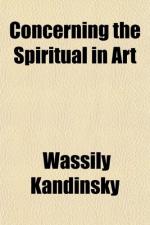There are, of course, many people who deny that Primitive Art had an inner meaning or, rather, that what is called “archaic expression” was dictated by anything but ignorance of representative methods and defective materials. Such people are numbered among the bitterest opponents of Post-Impressionism, and indeed it is difficult to see how they could be otherwise. “Painting,” they say, “which seeks to learn from an age when art was, however sincere, incompetent and uneducated, deliberately rejects the knowledge and skill of centuries.” It will be no easy matter to conquer this assumption that Primitive art is merely untrained Naturalism, but until it is conquered there seems little hope for a sympathetic understanding of the symbolist ideal.
The task is all the more difficult because of the analogy drawn by friends of the new movement between the neo-primitive vision and that of a child. That the analogy contains a grain of truth does not make it the less mischievous. Freshness of vision the child has, and freshness of vision is an important element in the new movement. But beyond this a parallel is non-existent, must be non-existent in any art other than pure artificiality. It is one thing to ape ineptitude in technique and another to acquire simplicity of vision. Simplicity—or rather discrimination of vision—is the trademark of the true Post-Impressionist. He observes and then selects what is essential. The result is a logical and very sophisticated synthesis. Such a synthesis will find expression in simple and even harsh technique. But the process can only come after the naturalist process and not before it. The child has a direct vision, because his mind is unencumbered by association and because his power of concentration is unimpaired by a multiplicity of interests. His method of drawing is immature; its variations from the ordinary result from lack of capacity.
Two examples will make my meaning clearer. The child draws a landscape. His picture contains one or two objects only from the number before his eyes. These are the objects which strike him as important. So far, good. But there is no relation between them; they stand isolated on his paper, mere lumpish shapes. The Post-Impressionist, however, selects his objects with a view to expressing by their means the whole feeling of the landscape. His choice falls on elements which sum up the whole, not those which first attract immediate attention.
Again, let us take the case of the definitely religious picture.
[Footnote: Religion, in the sense of awe, is present in all true art. But here I use the term in the narrower sense to mean pictures of which the subject is connected with Christian or other worship.]




